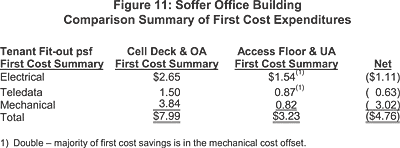Raised Access Floors: The Foundation of Flexibility and Efficiency
All successful LEED projects begin with a fully integrated design team, in which all professional disciplines work together toward the project goals. While each needs to be aware of the other's contributions and participate in the decision-making, none can or will have the knowledge and experience to complete a project unassisted. Hence, the use of a LEED Accredited Professional on the design team is recommended and most likely to garner the greatest success. For more information contact USGBC atwww.usgbc.org
Information About Case Studies
- A growing body of research has been emerging to study and assess raised access floors for commercial and institutional installations. The most referenced body of evidence includes several articles and reports prepared by public and private sources. These include an article appearing in
- Architectural Record in 1984, authored by Gary Hall, that analyzed the characteristics of using raised access floors based on a 10 percent churn rate. In 1997 AT&T prepared a similar report on Intelligent Building Analysis using a 30 percent churn rate. The most relevant article, perhaps, appeared in 1992 when the General Services Administration (GSA) prepared an analysis and report specifically investigating the advantages and disadvantages of the use of raised access floors. Details of this report are summarized below.
GSA Report #7211-911C
- Subject building size 251,000 total square feet, 150 square feet per work station
- Churn (change) rate: 20 percent
- Specific items addressed: Access floor system and modular
power system
Advantages determined in the report include:
- Lowest NPV
- Lowest initial cost of access floor option
- Lowest life cycle cost
- Easiest and fastest to reconfigure
- Lowest design coordination
- Lowest labor costs
- Highest residual property value
- Best solution for modular overhead lighting
Disadvantages identified include:
- Proprietary systems
- Greater floor-to-floor heights (potential reduction with underfloor supply air not evaluated)
- Regarding first costs, a private building cited by a raised access floor supplier has agreed with the results of the GSA study that first costs can be lower using a raised access floor with underfloor air distribution compared to a traditional structural floor system with overhead air distribution. First costs of tenant fit-out can also be analyzed. (Figure 11):
|
Peter J. Arsenault, AIA, NCARB, LEED-AP is an architect and consultant focused on green building and sustainable community planning, based near Syracuse, NY.









